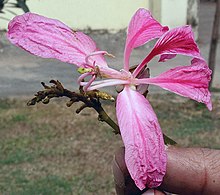Bauhinia purpurea: Difference between revisions
Changed category |
ThevikasIN (talk | contribs) added leaf and bark pictures |
||
| Line 30: | Line 30: | ||
[[File:Bauhinia purpurea (Kaniar) in Hyderabad, AP W2 IMG 2574.jpg|thumb|''Phanera purpurea'' flower (Kaniar) in Hyderabad, India.]] |
[[File:Bauhinia purpurea (Kaniar) in Hyderabad, AP W2 IMG 2574.jpg|thumb|''Phanera purpurea'' flower (Kaniar) in Hyderabad, India.]] |
||
''Phanera purpurea'' is a small to medium-size [[deciduous]] tree growing to {{convert|17|ft}} tall. The [[leaf|leaves]] are {{convert|10|–|20|cm}} long and broad, rounded, and bilobed at the base and apex. The [[flower]]s are conspicuous, pink, and fragrant, with five petals. The [[fruit]] is a [[legume|pod]] {{convert|30|cm}} long, containing 12 to 16 [[seed]]s. Leaves are alternate. |
''Phanera purpurea'' is a small to medium-size [[deciduous]] tree growing to {{convert|17|ft}} tall. The [[leaf|leaves]] are {{convert|10|–|20|cm}} long and broad, rounded, and bilobed at the base and apex. The [[flower]]s are conspicuous, pink, and fragrant, with five petals. The [[fruit]] is a [[legume|pod]] {{convert|30|cm}} long, containing 12 to 16 [[seed]]s. Leaves are alternate. |
||
[[File:Phanera purpurea leaf.JPG|thumb|Phanera purpurea leaf]] |
|||
[[File:Phanera purpurea bark.JPG|thumb|Phanera purpurea bark]] |
|||
==Cultivation== |
==Cultivation== |
||
Revision as of 08:54, 13 July 2017
| Bauhinia purpurea | |
|---|---|

| |
| Flower at Kolkata, West Bengal, India. | |
| Scientific classification | |
| Kingdom: | |
| (unranked): | |
| (unranked): | |
| (unranked): | |
| Order: | |
| Family: | |
| Genus: | |
| Species: | P. purpurea
|
| Binomial name | |
| Phanera purpurea | |
| Synonyms[3] | |
| |
Phanera purpurea is a species of flowering plant in the family Fabaceae, native to South China (which includes Hong Kong) and Southeast Asia. Common names include orchid tree,[4] Hong Kong orchid tree,[citation needed] purple bauhinia,[4] camel's foot,[4] butterfly tree,[4] and Hawaiian orchid tree.[citation needed]
Description

Phanera purpurea is a small to medium-size deciduous tree growing to 17 feet (5.2 m) tall. The leaves are 10–20 centimetres (3.9–7.9 in) long and broad, rounded, and bilobed at the base and apex. The flowers are conspicuous, pink, and fragrant, with five petals. The fruit is a pod 30 centimetres (12 in) long, containing 12 to 16 seeds. Leaves are alternate.


Cultivation
In the United States of America, the tree grows in Hawaii, coastal California, southern Texas, and southwest Florida. Bauhinia blakeana is usually propagated by grafting it onto P. purpurea stems.
Traditional medicine
Phanera purpurea is called Mandarai in Tamil and is used in traditional Tamil medicine in India.[citation needed]
Chemistry
A wide range of chemical compounds have been isolated from Phanera purpurea including 5,6-dihydroxy-7-methoxyflavone 6-O-β-D-xylopyranoside, bis [3',4'-dihydroxy-6-methoxy-7,8-furano-5',6'-mono-methylalloxy]-5-C-5-biflavonyl and (4'-hydroxy-7-methyl 3-C-α-L-rhamnopyranosyl)-5-C-5-(4'-hydroxy-7-methyl-3-C-α-D-glucopyranosyl) bioflavonoid, bibenzyls, dibenzoxepins, mixture of phytol fatty esters, lutein, β-sitosterol, isoquercitin and astragalin.[5]
References
- ^ Sinou C, Forest F, Lewis GP, Bruneau A (2009). "The genus Bauhinia s.l. (Leguminosae): a phylogeny based on the plastid trnL–trnF region". Botany. 87 (10): 947–960. doi:10.1139/B09-065.
- ^ Wunderlin RP (2010). "Reorganization of the Cercideae (Fabaceae: Caesalpinioideae)" (PDF). Phytoneuron. 48: 1–5.
- ^ "The Plant List: A Working List of All Plant Species".
- ^ a b c d "USDA GRIN Taxonomy".
- ^ Kumar T.; Chandrashekar K.S. Research (2011). "Bauhinia purpurea Linn.: A review of its ethnobotany, phytochemical and pharmacological profile". Journal of Medicinal Plant. 5 (4): 420–431. doi:10.3923/rjmp.2011.420.431.
